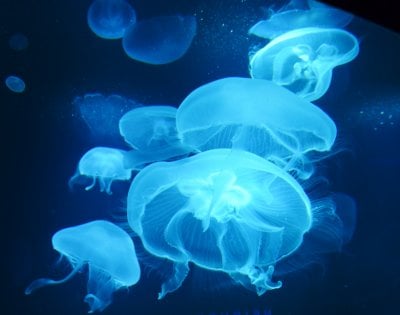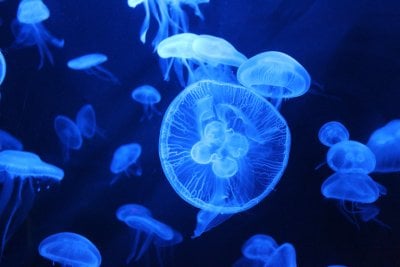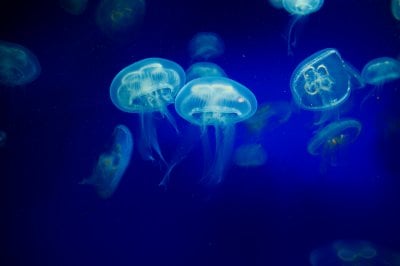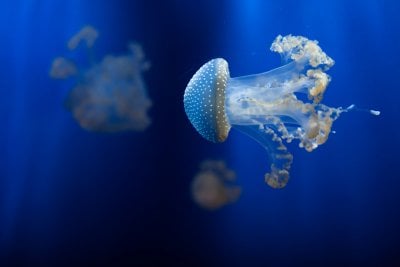- Joined
- Jun 14, 2016
- Messages
- 263
- Reaction score
- 518
To jellyfish or not to jellyfish, that is the question?
Not long ago, I bit the bullet and ordered one of the nano-jellyfish tanks currently on the market. For those unfamiliar, these tanks are a kreisel design. Kreisel is a German word for sphere or gyro and kreisel aquariums with built-in, yet independent filtration, have revolutionized our ability to keep sensitive species like jellyfish. The tank’s design and filtration layout mean that a soft gyre current consistently flows 360 degrees around the tank and plastic-screen mesh prevents delicate species from being sucked into the filtration chamber. This design is simple yet sophisticated and allows even a non-aquarist to keep jellyfish in a small, compact environment.
While the first month or two with the jellyfish tank was exciting and rewarding, I soon noticed some glaring issues, both with the tank’s design and with the idea of keeping jellyfish altogether. I do want to mention, please don’t accept my experience as the final verdict on jellyfish keeping. It remains an exciting area of marine aquaria and I am sure as time goes on, better designs and methodologies will make for a user friendly experience.
Jellyfish tanks:
Many of the jellyfish tanks in the marketplace aren’t marketed like traditional reef aquarium products. They are often sold as living art or a living display for the home. It’s a direct outreach to non-aquarists and creates the visage that jellyfish keeping is easy and requires little elbow-grease or aquatic expertise. The tank designs are unique and come in a myriad of shapes. Some are tall tubular cylinders, while others are complete half-circles and spheres. LED lighting is common on jellyfish tanks, allowing users to light their invertebrate pets under any color of the rainbow. The sleek, modern design of jellyfish tanks is neutral enough to blend with most home décor and is equally at home next to your computer, as it is next to some family pictures.
For me personally, the living art marketing style comes with caveats. I can’t help but draw comparisons of this, to the living art products sold in China (think of little, live turtles in a sealed-up necklaces). That’s likely an overly brutal comparison but it did come to mind as I browsed jellyfish tank options. Anytime you market an animal as art or home decor, the lines get blurry from a standpoint of ethics, at least for me. Anti-aquarium activists and legislators often accuse reef aquarists of viewing corals and fish as little more than expendable home décor. As I’ve stated many times, I don’t believe that to be the case at all, but marketing a marine aquarium (of any type) to non-aquarists as a form of art or décor will only strengthen their case.
Like any pet, jellyfish keeping is an expense and responsibility. Luckily the jellyfish offered (usually moon jellyfish) with most packages are captive bred and raised, meaning that the jellyfish fad shouldn’t affect wild ecosystems. The package I purchased had adequate filtration, with an area for carbon media, live rock rubble and mechanical filtration floss. A small pump (like what is found on desktop fountains) moved water around the circular tank, creating the gyre current and pushing water over filtration media.
The lighting system was solely LED, allowing for a variety of color changes via a remote control. These LED systems aren’t unlike those sold at Home Depot, which can be installed by home owners under cabinets, etc. Like most jellyfish tanks, mine was all acrylic and plastic. The design of many nano-jellyfish aquariums recreates the unique porthole display common in many public aquariums, simply reducing it to a small, manageable home aquarium.
Some drawbacks:
I hate to say it again, but at face-value, even once set-up, running and stocked with moon jellies, a nano-jellyfish tank seemed like a unique, easy to care for display. I used cycled marine water from my reef tank and instead of implementing the dry live rock rubble that came with the tank, I broke up some live rock from my sump. Moon jellies tolerate temperature ranges anywhere from 50-80 degrees, so there is no need to install a heater, if their tank is kept in a 70-75-degree room. The LED lighting created a rich, dynamic display.
The jellyfish kit I purchased and most I’ve seen on the market include what is labeled, “planktonic jellyfish food.” Based on my inspection, these appear to be brine-shrimp eggs or at least something quite similar. Moon jellyfish are translucent, allowing their keeper to see food build-up on their tentacles and make its way to their digestive system (the upper part of their bell). Sort of a unique novelty, but it wears off fast. Sadly, all foods tend to gather at the bottom of the tank. Since jellyfish can only grab free floating food, the pile up is quite noticeable. Within just a few days, most the food was piled up at the bottom. I was feeding less than the amount recommended within the tank’s care guide. I experimented with a few foods that I thought might be easier for the jellies to snag and provide more nutrition (primarily foods like reef roids and reef chili) but the effect was the same.
The food pile up requires a very frustrating tank breakdown to clean-up. Since the circular design leaves little room between the tank back and front pane it’s almost impossible to simply reach down and manually remove the food. Jellyfish are easily sucked through a siphon hose and when they are, it often damages their bell. A food siphoning clean damaged several of my jellies bells and both died within a few hours. After realizing that siphoning the un-eaten food out was risky, difficult and frustrating, I thought that perhaps turning the flow up on the pump would allow better circulation and thus pull the food out and into the filtration mesh.
It worked, most of the food build-up was quickly whisked away. Also, the pump could easily be turned off during feeding, allowing the jellies plenty of time to snatch food in a soft current. The downside, any amount of current beyond a gentle, circular tumble of water and the jellyfish get damaged. By damaged I mean tentacles torn off, bells ripped open, both often fatal injuries. After experimenting with multiple flow rates, I was simply unable to find one that reconciled the safety of the animals with removal of uneaten food. Left to its own devices, the tank started to look gross, fast.
I decided a more pro-active approach was in order. I used a brine shrimp net to remove the jellyfish and placed them in a bucket. I was then able to siphon out both water and uneaten food, conducting a total tank clean. To my surprise, the circular design of the tank was so difficult to get food out of, that even after nearly removing 50% of the tank’s water, lots of food remained. So much in fact, that once I had the tank up and running with the jellies back inside, I could barely tell I had made a real dent in the buildup.
In another attempt, I decided to add a few hermits to the tank, hoping they would eat the built-up food. To a degree it worked, but as soon as the hermits reached the curvature of the sphere, they simply rolled in the current and retreated into their shells. Snails worked a bit better, but ignored most of the food and consistently ended up in the filtration chamber stuck to the pump. When there isn’t current in their tank, jellies simply sink to the bottom, which isn’t good for them and for me, led to more torn tentacles and bells.
My final attempt was to remove the jellyfish to a bucket and siphon all the water out. Even then, it required a thin shop-vac attachment to remove all the uneaten food. While I used saltwater that matched the temperature and salinity of the jellies’ tank water, within 24 hours, most of my jellyfish were dead. Slowly, you could watch them dissolve hour by hour. A bitter end to a frustrating endeavor.
There isn’t any aquarium related challenge I back away from. In fact, over my 20-year career as an aquarist, I have covered a wide, wide gamut of fish and reef keeping. Not to sound like a snob, but I’ve kept just about every style of marine aquarium out there. While many were far more work than a little four-gallon jellyfish tank, the difference was reward. Yes, the jellyfish display is cool and they are interesting creatures, that’s not up for debate. In many ways, they create a striking, otherworldly exhibition. However, for me, there are simply too many drawbacks to these nano-all-in-one jellyfish tanks. Every husbandry detail is wrought with challenge, after challenge and eventually you’re up against four gallons of insurmountable odds. This is all without mentioning the supreme aggravation of trying to remove algae from the acrylic viewing pane, or the fact that if left unattended, all that uneaten food leads to an epic nitrate spike that turns the tank green.
Before writing this, I reached out to a few fellow aquarists that I know had also set-up a jellyfish tank like mine. They’re all long-time aquarists who are slow to shy away from an aquatic challenge. They too reported similar experiences and like my jellyfish tank, theirs was empty, shoved away in a basement or garage. When I realized that it took about the same amount of time (and arguably more frustration) to maintain a four-gallon jellyfish tank, than it did my 250-gallon reef, I decided the jellyfish number was up. Not only had the novelty worn off, it was replaced with sheer displeasure.
Jellies do have a future:
All of this revealed, I know some aquarists who are so fascinated by jellyfish, that they may be willing to accept the frustration to have such a radically different display in their home or fish room. For them, a tank like mine might be a perfectly fine investment. I’ve never been overly entranced by jellyfish so I might be more likely to call foul when they’re the only species a tank houses. This is one area of aquaria where I think a larger, more complex system would be far easier to maintain, in the long run. Popular all-in-one jelly tanks are fool proof in their set-up but rigorous to maintain.
Hopefully the designers behind the wave of desktop jellyfish tanks will continue to innovate and come up with a system that mitigates waste along with maintaining an environment suitable for the jellyfish. The concept is sound; it just needs a bit more time in the oven.
Not long ago, I bit the bullet and ordered one of the nano-jellyfish tanks currently on the market. For those unfamiliar, these tanks are a kreisel design. Kreisel is a German word for sphere or gyro and kreisel aquariums with built-in, yet independent filtration, have revolutionized our ability to keep sensitive species like jellyfish. The tank’s design and filtration layout mean that a soft gyre current consistently flows 360 degrees around the tank and plastic-screen mesh prevents delicate species from being sucked into the filtration chamber. This design is simple yet sophisticated and allows even a non-aquarist to keep jellyfish in a small, compact environment.
While the first month or two with the jellyfish tank was exciting and rewarding, I soon noticed some glaring issues, both with the tank’s design and with the idea of keeping jellyfish altogether. I do want to mention, please don’t accept my experience as the final verdict on jellyfish keeping. It remains an exciting area of marine aquaria and I am sure as time goes on, better designs and methodologies will make for a user friendly experience.
Jellyfish tanks:
Many of the jellyfish tanks in the marketplace aren’t marketed like traditional reef aquarium products. They are often sold as living art or a living display for the home. It’s a direct outreach to non-aquarists and creates the visage that jellyfish keeping is easy and requires little elbow-grease or aquatic expertise. The tank designs are unique and come in a myriad of shapes. Some are tall tubular cylinders, while others are complete half-circles and spheres. LED lighting is common on jellyfish tanks, allowing users to light their invertebrate pets under any color of the rainbow. The sleek, modern design of jellyfish tanks is neutral enough to blend with most home décor and is equally at home next to your computer, as it is next to some family pictures.
For me personally, the living art marketing style comes with caveats. I can’t help but draw comparisons of this, to the living art products sold in China (think of little, live turtles in a sealed-up necklaces). That’s likely an overly brutal comparison but it did come to mind as I browsed jellyfish tank options. Anytime you market an animal as art or home decor, the lines get blurry from a standpoint of ethics, at least for me. Anti-aquarium activists and legislators often accuse reef aquarists of viewing corals and fish as little more than expendable home décor. As I’ve stated many times, I don’t believe that to be the case at all, but marketing a marine aquarium (of any type) to non-aquarists as a form of art or décor will only strengthen their case.
Like any pet, jellyfish keeping is an expense and responsibility. Luckily the jellyfish offered (usually moon jellyfish) with most packages are captive bred and raised, meaning that the jellyfish fad shouldn’t affect wild ecosystems. The package I purchased had adequate filtration, with an area for carbon media, live rock rubble and mechanical filtration floss. A small pump (like what is found on desktop fountains) moved water around the circular tank, creating the gyre current and pushing water over filtration media.
The lighting system was solely LED, allowing for a variety of color changes via a remote control. These LED systems aren’t unlike those sold at Home Depot, which can be installed by home owners under cabinets, etc. Like most jellyfish tanks, mine was all acrylic and plastic. The design of many nano-jellyfish aquariums recreates the unique porthole display common in many public aquariums, simply reducing it to a small, manageable home aquarium.
Some drawbacks:
I hate to say it again, but at face-value, even once set-up, running and stocked with moon jellies, a nano-jellyfish tank seemed like a unique, easy to care for display. I used cycled marine water from my reef tank and instead of implementing the dry live rock rubble that came with the tank, I broke up some live rock from my sump. Moon jellies tolerate temperature ranges anywhere from 50-80 degrees, so there is no need to install a heater, if their tank is kept in a 70-75-degree room. The LED lighting created a rich, dynamic display.
The jellyfish kit I purchased and most I’ve seen on the market include what is labeled, “planktonic jellyfish food.” Based on my inspection, these appear to be brine-shrimp eggs or at least something quite similar. Moon jellyfish are translucent, allowing their keeper to see food build-up on their tentacles and make its way to their digestive system (the upper part of their bell). Sort of a unique novelty, but it wears off fast. Sadly, all foods tend to gather at the bottom of the tank. Since jellyfish can only grab free floating food, the pile up is quite noticeable. Within just a few days, most the food was piled up at the bottom. I was feeding less than the amount recommended within the tank’s care guide. I experimented with a few foods that I thought might be easier for the jellies to snag and provide more nutrition (primarily foods like reef roids and reef chili) but the effect was the same.
The food pile up requires a very frustrating tank breakdown to clean-up. Since the circular design leaves little room between the tank back and front pane it’s almost impossible to simply reach down and manually remove the food. Jellyfish are easily sucked through a siphon hose and when they are, it often damages their bell. A food siphoning clean damaged several of my jellies bells and both died within a few hours. After realizing that siphoning the un-eaten food out was risky, difficult and frustrating, I thought that perhaps turning the flow up on the pump would allow better circulation and thus pull the food out and into the filtration mesh.
It worked, most of the food build-up was quickly whisked away. Also, the pump could easily be turned off during feeding, allowing the jellies plenty of time to snatch food in a soft current. The downside, any amount of current beyond a gentle, circular tumble of water and the jellyfish get damaged. By damaged I mean tentacles torn off, bells ripped open, both often fatal injuries. After experimenting with multiple flow rates, I was simply unable to find one that reconciled the safety of the animals with removal of uneaten food. Left to its own devices, the tank started to look gross, fast.
I decided a more pro-active approach was in order. I used a brine shrimp net to remove the jellyfish and placed them in a bucket. I was then able to siphon out both water and uneaten food, conducting a total tank clean. To my surprise, the circular design of the tank was so difficult to get food out of, that even after nearly removing 50% of the tank’s water, lots of food remained. So much in fact, that once I had the tank up and running with the jellies back inside, I could barely tell I had made a real dent in the buildup.
In another attempt, I decided to add a few hermits to the tank, hoping they would eat the built-up food. To a degree it worked, but as soon as the hermits reached the curvature of the sphere, they simply rolled in the current and retreated into their shells. Snails worked a bit better, but ignored most of the food and consistently ended up in the filtration chamber stuck to the pump. When there isn’t current in their tank, jellies simply sink to the bottom, which isn’t good for them and for me, led to more torn tentacles and bells.
My final attempt was to remove the jellyfish to a bucket and siphon all the water out. Even then, it required a thin shop-vac attachment to remove all the uneaten food. While I used saltwater that matched the temperature and salinity of the jellies’ tank water, within 24 hours, most of my jellyfish were dead. Slowly, you could watch them dissolve hour by hour. A bitter end to a frustrating endeavor.
There isn’t any aquarium related challenge I back away from. In fact, over my 20-year career as an aquarist, I have covered a wide, wide gamut of fish and reef keeping. Not to sound like a snob, but I’ve kept just about every style of marine aquarium out there. While many were far more work than a little four-gallon jellyfish tank, the difference was reward. Yes, the jellyfish display is cool and they are interesting creatures, that’s not up for debate. In many ways, they create a striking, otherworldly exhibition. However, for me, there are simply too many drawbacks to these nano-all-in-one jellyfish tanks. Every husbandry detail is wrought with challenge, after challenge and eventually you’re up against four gallons of insurmountable odds. This is all without mentioning the supreme aggravation of trying to remove algae from the acrylic viewing pane, or the fact that if left unattended, all that uneaten food leads to an epic nitrate spike that turns the tank green.
Before writing this, I reached out to a few fellow aquarists that I know had also set-up a jellyfish tank like mine. They’re all long-time aquarists who are slow to shy away from an aquatic challenge. They too reported similar experiences and like my jellyfish tank, theirs was empty, shoved away in a basement or garage. When I realized that it took about the same amount of time (and arguably more frustration) to maintain a four-gallon jellyfish tank, than it did my 250-gallon reef, I decided the jellyfish number was up. Not only had the novelty worn off, it was replaced with sheer displeasure.
Jellies do have a future:
All of this revealed, I know some aquarists who are so fascinated by jellyfish, that they may be willing to accept the frustration to have such a radically different display in their home or fish room. For them, a tank like mine might be a perfectly fine investment. I’ve never been overly entranced by jellyfish so I might be more likely to call foul when they’re the only species a tank houses. This is one area of aquaria where I think a larger, more complex system would be far easier to maintain, in the long run. Popular all-in-one jelly tanks are fool proof in their set-up but rigorous to maintain.
Hopefully the designers behind the wave of desktop jellyfish tanks will continue to innovate and come up with a system that mitigates waste along with maintaining an environment suitable for the jellyfish. The concept is sound; it just needs a bit more time in the oven.
Last edited by a moderator:





















